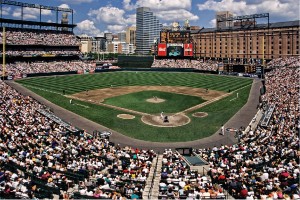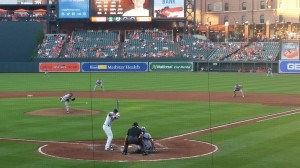Waiting for the Weekend: MLB Is Trying to Force the Orioles Out Of Baltimore
I used to think that the New York Yankees were the greatest enemy of my favorite team the Baltimore Orioles. However, it is now becoming abundantly clear that the greatest threats to the future of the Orioles is not a division rival, but instead the evil duo of the Washington Nationals and Major League Baseball.
While it may take another decade or two to come to fruition, it now seems abundantly clear that the goal of the Nationals and Major League Baseball is to force the Orioles out of the city they have called home since 1954 (during which time three different franchises have called Washington home).
Considering that for 50 years the Orioles were one of the model franchises of the league, the fall from grace is quite surprising and disappointing.
It all started when Major League Baseball seized ownership of the Montreal Expos and in 2005 moved the team to Washington, DC.
At that time, Baltimore owner Peter Angelos fought the effort to move the team fearing that it would negatively impact the Orioles television revenue and fan base since Northern Virginia and Washington had long been an important part of the fan base for the Orioles, but while he could not stop the move, he did get some short-term financial concessions.
The Orioles received majority ownership of the MASN (Mid-Atlantic Sports Network) network and were given the rights to broadcast Nationals games at a discount from 2005 through 2011. While this was a short-term win for the Orioles, it seemed to have created resentment from both the Nationals and MLB.
When the initial broadcast compensation agreement ended in 2012, the Orioles were looking to secure future rights at a rate of $34 million per year, but the Nationals and MLB wanted closer to $100 million. Eventually, an arbitration panel made up of executives from other franchises said the value was as much as $66 million. The Orioles appealed the ruling saying the rate should be decided by a group not selected by MLB. The case was in the courts for several years before the ruling came back this week saying that MLB had the right to select the arbitrators.
So, in the five years that this issue has been festering, it appears that MLB and the Nationals have decided that they don’t just want more money from the Orioles TV network, they eventually want the Orioles out of the market.
There is no arguing that Angelos was correct that adding the Nationals less than an hour away from the home of the Orioles has negatively impacted the Baltimore franchise, but I bet even Angelos didn’t know it would be as significant as it has turned out.
Thanks in part to having the best baseball stadium in the league, for the decade and a half prior to the Nationals arrival in the market, the Orioles were always among the top franchises in MLB in annual attendance, regardless of whether the team on the field was competitive.
Even as the rest of baseball struggled to regain fans after the 1994 strike, the Orioles were drawing record crowds.
Between 1995 and 2005, the Orioles averaged 3,133,814 and annually ranked near the top in annual attendance in the league. Even when the Orioles went without a winning season from 1998 through 2005, their annual attendance was still high.
However, starting in 2006 and continuing to now, the Orioles have seen a dramatic decline in attendance. In fact, as a lifelong Baltimore fan, it is embarrassing to watch them play games against rivals like the Yankees or Red Sox with complete sections almost empty. They might as well not even play home games during the week as attendance is lucky to reach 15,000 and even on the weekends the number of empty seats is shocking. My son and I recently went to a Saturday afternoon game and were amazed to see how many seats were open (picture above), definitely different to when I went to Orioles games in the 1990s when you had to purchase seats months in advance just to sit in the upper deck.
In the 11 seasons between 2006 and 2016, the Orioles averaged 2,094,681 fans per season, an average decline of MORE THAN A MILLION FANS PER YEAR. For anyone who wants to say that the reason for this dramatic drop in attendance is because of on-the-field performance instead of the Nationals, the numbers do not support your argument. Between 2000-2005, the Orioles did not have a winning record, but averaged 2,816,265 fans per year. The Orioles did not have a losing record in the five seasons between 2012 and 2016, but averaged only 2,275,564 fans per game.
Here is the full breakdown in attendance from 1995-2016:
Orioles average annual attendance 1995-2005: 3,133,814
Orioles average annual attendance 2000-2005: 2,816,265 (all losing years)
Orioles average annual attendance 2006-2016: 2,094,681
Orioles average annual attendance 2012-2016: 2,275,564 (all .500 or better seasons)
So, it seems fair that the Orioles would have some claim to compensation from MLB and the Nationals for the significant reduction in revenue the team has seen by losing over a million fans per season.

In 1996 and through the early 200s the Orioles played to a full house at Camden Yards almost every night.
However, instead of trying to help ensure the Orioles can remain competitive, it appears that MLB and the Nationals have instead doubled-down and seem to now have a long-term plan to eventually eliminate the Orioles from the Northern Virginia/Washington DC/Baltimore market so they can have it all for themselves.
Baltimore has not hosted the All-Star Game since 1993, the second year of Camden Yards. They put in a bid to host the game in 2016, but were denied. The game will be in Washington in 2018, marking the fourth straight year the game will be in a National League ballpark. The 2019 game will be in Cleveland, which last hosted the All-Star Game in 1997.
Hosting the All-Star Game would be a huge financial benefit for the Orioles and help recoup some of the revenue they are losing annually due to the attendance drop they have seen since the arrival of the Nationals.
Growing their revenue is critical for the Orioles as they near a time when some of their top young stars are getting close to free agency.
Baltimore lost one of the players they long thought would be an organizational pillar in 2017 when they did not resign Matt Wieters, who ironically, moved down the road to the Nationals.
Over the next couple years, marquee young infielders Manny Machado and Jonathan Schoop will be reaching free agency. If the Orioles are unable to resign them, it could create a negative spiral for the franchise from which they may not be able to recover.
At the very least, because of MLB and the Nationals, the Orioles seem to now be resigned to the same type of pendulum that other lower tier franchises like the Pirates, Royals, A’s, Marlins, Reds, Astros and Brewers are in where they build their young talent and have a small window to compete before those players leave by free agency and they have to go back to struggling and building again. To the contrary, larger market teams like the Red Sox, Yankees, Dodgers and Nationals generally do not see the same prolonged swings as they have the money to buy top talent whenever they want to complement their own homegrown players.
But, for the Orioles, at some point the magic of having a great stadium in Camden Yards may not be enough, especially with the Nationals less than an hour down the road.
Much like what happened to the Montreal Expos when they were unable to resign their young stars in the 1990s and eventually played in a nearly empty stadium before moving to Washington, if the Orioles are unable to retain their young stars and have another period like their stretch of 14 consecutive losing years from 1998 through 2011 it may be more than a reduced fan base can handle.
Interestingly enough, the Nationals ownership has tried to argue that not receiving higher television revenue from MASN has hampered their ability to compete, yet they seem to be having no problem signing free agents and their own young talent to mammoth contracts.
In 2015 the Nationals signed top free agent pitcher Max Scherzer to a contract that pays him more than $22 million per year through 2021. In addition, they have signed former number one draft pick pitcher Stephen Strasburg to a seven year, $175 million contract that should keep him with the Nationals through 2023.
Of course MLB and the Nationals will not publicly acknowledge that they are trying to create a situation in Baltimore where moving the franchise becomes the only logical way of growing revenue and competing, but it sure seems like the wheels are in motion.
There is no question that Peter Angelos and the Baltimore ownership has made some questionable decisions over the years, but with the future of their franchise on the line, continuing to fight against the Nationals and MLB is something they must continue to do.
Hopefully this time they will eventually come out on top.











